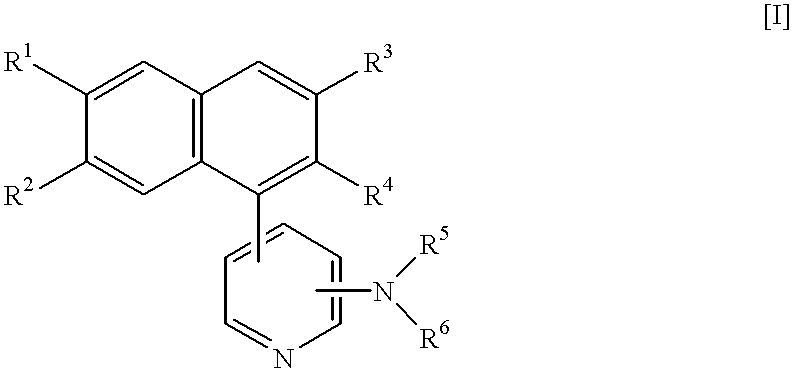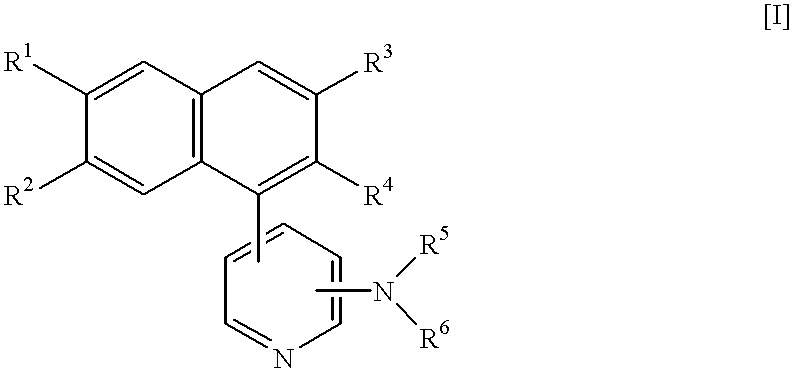Naphthalene derivatives, process for the preparation thereof, and intermediates therefor
a technology of naphthalene and derivatives, which is applied in the field of naphthalene derivatives, can solve the problem of not disclosing 1-pyridylnaphthalene derivatives
- Summary
- Abstract
- Description
- Claims
- Application Information
AI Technical Summary
Problems solved by technology
Method used
Image
Examples
example 2
To a suspension of 1-(4-pyridyl)-2,3-bis(acetoxymethyl)-6,7-dimethoxynaphthalene N-oxide (2.3 g) and 2-chloroquinoline (1.64 g) in dimethylformamide (5 ml) is poured several drops of a solution of hydrogen chloride in dioxane, and the mixture is heated with stirring at 120-130.degree. C. After the reaction is complete, the mixture is concentrated under reduced pressure to remove the solvent, and methylene chloride and an aqueous sodium hydrogen carbonate solution are added to the resulting residue. The methylene chloride layer is separated, washed, dried, and concentrated under reduced pressure to remove the solvent. To the residue are added pyridine (5 ml) and acetic anhydride (1.0 ml) under ice-cooling, an d t he mixture is stirred at room temperature for two hours. After the reaction is complete, the mixture is concentrated under reduced pressure to remove the solvent, and to the residue are added ethyl ace:ate and water. The ethyl acetate layer is separated, washed, dried and co...
example 3
To a suspension of 1-(4-pyridyl)-2,3-bis(acetoxymethyl)-6,7-dimethoxynaphthalene N-oxide (3.5 g) and 2-chloro-5-nitropyridine (13.0 g) in xylene (30 ml) is added several drops of a solution of hydrogen bromide in acetic acid, and the mixture is heated with stirring at 140-150.degree. C. After the reaction is complete, the mixture is concentrated under reduced pressure to remove the solvent, and chloroform and an aqueous sodium hydrogen carbonate solution are added to the resulting residue. The chloroform layer is separated, washed, dried, and concentrated under reduced pressure to remove the solvent. The residue is purified by silica gel column chromatography (solvent; chloroform:acetone=50:1) to give 1-{2-[2-oxo-1,2-dihydro-2-nitropyridin-1-yl]-4-pyridyl}-2,3-bis) (acetoxymethyl)-6,7-dimethoxynaphthalene (1.83 g) which is listed in Table 1.
M.p. 81-84.degree. C.
example 4
To a solution of 1-[2-(1-oxo-1,2-dihydroisoquinolin-2-yl)-4-pyridyl]-2,3-bis(acetoxymethyl)-6,7-diethoxynaphthalene (1.84 g) in methanol (50 ml) is added sodium methoxide (0.52 g) under ice-cooling. The mixture is stirred at room temperature for 2.5 hours. To the mixture is added sodium methoxide (0.17 g) under ice-cooling, and the mixture is stirred at room temperature for one hour. Acetic acid (0.74 ml) is added to the reaction mixture under ice-cooling, and the mixture is Concentrated under reduced pressure to remove the solvent. To the residue are added methylene chloride and an aqueous sodium hydrogen carbonate solution, and the methylene chloride layer is separated, washed, dried and concentrated under reduced pressure to remove the solvent. The residue is purified by silica gel column chromatography (solvent; chloroform:ethanol=25:1) to give 1-[2-(1-oxo-1,2-dihydroisoquinolin-2-yl)4-pyridyl]-2,3-bis(hydroxymethyl)-6,7-diethoxynaphthalene (0.95 g) which is listed in Table 1.
M....
PUM
| Property | Measurement | Unit |
|---|---|---|
| Temperature | aaaaa | aaaaa |
| Temperature | aaaaa | aaaaa |
| Temperature | aaaaa | aaaaa |
Abstract
Description
Claims
Application Information
 Login to View More
Login to View More - R&D
- Intellectual Property
- Life Sciences
- Materials
- Tech Scout
- Unparalleled Data Quality
- Higher Quality Content
- 60% Fewer Hallucinations
Browse by: Latest US Patents, China's latest patents, Technical Efficacy Thesaurus, Application Domain, Technology Topic, Popular Technical Reports.
© 2025 PatSnap. All rights reserved.Legal|Privacy policy|Modern Slavery Act Transparency Statement|Sitemap|About US| Contact US: help@patsnap.com



